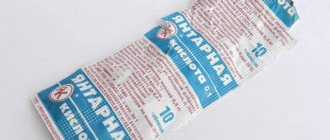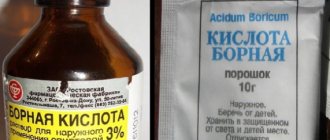Hydrochloric acid (HCl, hydrochloric acid, hydrogen chloride) is a colorless, caustic liquid with a specific odor, one of the strongest acids, capable of dissolving many metals. Produced by dissolving hydrogen chloride gas in water.
Source: depositphotos.com
In air, hydrochloric acid smokes, because the released HCl forms tiny droplets and fog with water vapor.
Hydrogen chloride used in production has a yellow-green color due to impurities of iron and chlorine salts. Its industrial application is very wide:
- hydrometallurgy of precious metals;
- electrotype;
- production of chloride salts;
- tanning and dyeing of leather in the leather industry;
- production of adhesives, alcohols, acids;
- pharmaceutical production;
- textile industry, etc.
In a concentration of 0.3 to 0.5%, hydrochloric acid is found in the body under normal conditions, being the main component of gastric juice. Its aggressive properties allow it to effectively protect the body from viruses and bacteria entering the gastrointestinal tract. In addition to its protective function, hydrochloric acid promotes the normal process of digestion, stimulates the pancreas, participates in the synthesis of hormones, and under its influence the ripening of digestive enzymes of gastric juice occurs.
At a concentration of 24 to 38% it is highly toxic, and therefore the circulation of acid of such saturation in the Russian Federation is limited. A particular danger when working with concentrated HCl solutions is the mists that form when it comes into contact with air, due to the ability to cause damage to the eyes and respiratory system. If it comes into contact with the skin, the concentrated acid causes a chemical burn.
The lethal dose when taken orally is 15-20 ml of concentrated acid.
Hydrochloric acid vapor poisoning: symptoms and treatment
Hydrochloric acid poisoning through the oral cavity occurs when the poison is swallowed. As a rule, this most often happens in people who are prone to suicide and children who drank the substance as a result of parental inattention. In this case, the following symptoms are noted:
- pain and burning in the mouth,
- nausea, brownish-black vomiting, often mixed with blood,
- coughing,
- profuse salivation,
- painful sensations in the esophagus, stomach, behind the sternum,
- the tongue turns black
- the skin may become yellowish,
- Painful sensations appear in the right side due to liver dysfunction.
How to protect yourself
Both at home and at work, you should strictly follow the rules for preventing poisoning:
- work with acid in special clothing that protects all parts of the body;
- be sure to use additional protective equipment (goggles, gloves, respirator, gloves);
- monitor proper ventilation in the room;
- containers with acid should be put away in places where no one (especially children) can get it by accident.
Poisoning with hydrochloric acid means getting very serious health problems. Contact with even a tiny amount of the chemical will result in severe complications for the victim or at least memories of the pain suffered.
First aid for burns and hydrochloric acid poisoning
The toxicity of the substance lies in the fact that the liquid evaporates in air, releasing gas. It enters the human body through mucous membranes and skin. If it comes into contact with the skin, the acid causes a severe chemical burn. Every person's stomach also contains hydrochloric acid. It helps the digestive processes. People who have low acidity are prescribed medications with this substance. Hydrogen chloride solution is also used as a food additive E 507.
Hydrochloric acid
- a thing in many industries that is simply irreplaceable.
Metallurgy, food production, electroplating, medicine - these and many other areas today are difficult to imagine without the use of acids. Unfortunately, not everyone knows what technical hydrochloric acid
, how it is produced and where it is used.
We will try to correct this situation - we will consider these issues and note the most important points that relate to such an important and irreplaceable chemical product as hydrochloric acid
.
Chronic poisoning (symptoms)
Irritation of the conjunctiva, mucous membrane of the upper respiratory tract, hypertrophic and atrophic rhinitis, possible ulceration and perforation of the nasal septum; laryngitis, tracheitis, bronchitis with bronchospastic components Bronchial asthma (sulfuric acid).
We recommend reading: Why a woman constantly wants to sleep - reasons, treatment
Damage to the teeth - the appearance of brown spots on the incisors (hydrochloric acid), destruction of the crowns of the teeth. Concentrated acid solutions have a cauterizing effect on the skin, causing deep, difficult-to-heal “bird's eye” ulcers to develop.
Work ability examination
Acute severe poisoning can lead to serious complications (chronic bronchitis, chronic pneumonia, pneumosclerosis, corneal damage, scarring of the skin); in case of oral poisoning - disruption of the structure and function of the esophagus and stomach. Possible permanent disability.
Where is it used?
Caustic hydrochloric acid has found application in industry and medicine. Hydrometallurgy and electroplating are impossible without the use of hydrogen chloride. It is used to clean the surface of metals and ceramics, and various chlorides are obtained with its help.
Cleaning metal from cement with hydrochloric acid
In its natural form, hydrochloric acid is found in gastric juice, being an integral part of it. For low stomach acidity, patients are prescribed a weak solution of hydrogen chloride in combination with pepsin (a digestive enzyme) orally.
This is interesting! Hydrochloric acid is even registered as a food additive as an acidity regulator (E507).
Symptoms of hydrogen chloride poisoning
Poisoning with hydrochloric acid appears immediately after contact with it.
The victim's condition is rapidly deteriorating and he needs urgent help. The table below shows the symptoms of hydrogen chloride poisoning.
| Mechanism of impact | Symptoms and signs |
| Inhalation |
|
| Ingestion |
|
| Contact with skin or mucous membranes |
|
Chemical damage to the skin
Burns occur as a result of exposure of the skin to high temperatures (thermal), electric fields (electric), acids or alkaline substances (chemical) and electromagnetic radiation (radial). Thermal burns are common in everyday life.
Damage to the skin caused by chemicals is difficult to treat. The degree of harm is determined by the amount and concentration of the acid or alkali, the characteristics of exposure and behavior when in contact with water or air, as well as the period of stay on the skin or mucous membranes. Doctors distinguish the following degrees of severity of a chemical burn:
- I – redness of the affected area and pain;
- II – swelling and blisters with transparent contents appear;
- III – necrosis of the upper layers of skin and blisters with cloudy liquid or blood;
- IV – deep lesion that reaches the muscles and tendons.
Doctors are more likely to encounter severe cases of grades III and IV due to the fact that the chemical composition of the substances is very toxic and acts instantly. Therefore, people should know the symptoms of an acid burn and the basics of emergency care in such situations in order to maintain their health or be able to provide first aid.
If hydrochloric acid comes into contact with the skin, rinse the area with clean water.
Prevention methods
- Store the acid correctly: the container must be special, acid-resistant, and the storage location must be out of reach of children. The bottle must be marked, and so that even a child can understand it, there must be an expressive sticker with symbols of mortal danger. Never pour acids into glass drink bottles to prevent children from drinking them by mistake.
- Strictly adhere to all safety rules before and while working with aggressive chemicals: wear gloves and protective clothing to protect your skin, use goggles and a respirator to protect your mucous membranes, and always check the ventilation.
Acids are used extremely widely - for the production of a number of other acids, for pickling metals, in the metallurgy of non-ferrous and rare metals, in the synthesis of many organic substances, in the production of dyes, fertilizers, explosives, etc. Acid vapors enter the body through the respiratory system. It is possible to take acids by mouth - accidentally or for suicidal purposes. They have a sharply irritating and cauterizing effect on the mucous membranes and skin, causing burns and coagulative necrosis of tissue proteins. Contact with eyes is very dangerous. Acids also have a resorptive effect. The development of acute renal failure, in particular with oral administration of acetic acid, is a sharp hemolysis of red blood cells, blockage of the renal tubules with clumps of disintegrated red blood cells. Reduced immunobiological reactivity of the body.
- pain in the chest and throat area,
- nosebleeds and vomiting of blood in case of high vapor concentrations,
- painful cough.
- hoarseness,
- feeling of lack of air, suffocation,
- pain in the eyes and painful reaction to light,
- redness of the conjunctiva,
- lacrimation,
- asphyxia, swelling of the mucous membranes of the larynx, bronchi, and then the lungs, which can cause the death of the victim.
What is the healing process?
The actual treatment and relief of pain is as follows:
- If the mucous membranes of the respiratory tract, nose and mouth are affected, rinse with a two percent soda solution, and also prescribe warm milk with soda or Borjomi water; for coughing -
- If it gets into the eyes, doctors will instill an antibiotic (for example, chloramphenicol) and painkillers (Novocaine, Dicaine), and then inject sterile peach or petroleum jelly into the conjunctival sac. Next, it is recommended to wear dark glasses so that your eyes are not further irritated by bright light.
- If the skin is burned, wet furatsilin dressings are applied after washing to prevent the development of infection in the wounds. For minor burns (1st degree), methylene blue can be used. In case of more severe damage (2nd degree burn), after treating the skin with alcohol and removing the blisters, a bandage soaked in an anesthetic is applied.
- If the mucous membranes of the oral cavity are affected, they are treated with a solution of dicaine (2%). Every 2 hours, the oral cavity is treated with a mixture of vegetable oil with an antibiotic and anesthetic.
- If the acid gets inside, into the esophagus and stomach, anesthesia with promedol or morphine is necessary, and then emergency rinsing with cold water with the addition of milk or egg white using an oil-treated probe. If it is not possible to rinse the stomach with a tube, antiemetics are not used, but induce vomiting by pressing on the root of the tongue after drinking at least 3-5 glasses of cool water (repeat 3-4 times). It is also necessary to take mucous-enveloping agents internally: beaten egg whites, milk, vegetable oil, mucous decoctions (for example, flaxseed). Small pieces of ice that are swallowed and an ice pack on the stomach also help. Next, forced diuresis is carried out.
Important: soda should not be used internally, as it causes abundant gas release when reacting with acid, which further injures the mucous membranes. Laxatives are also not used, so as not to provoke acid damage to the entire intestine.
- Relieving pain is necessary to prevent shock, so analgesics are prescribed.
- Symptomatic treatment is also prescribed: cardiac medications for cardiac dysfunction, detoxification to prevent kidney and liver damage, antibiotics to prevent the development of infections, etc.
We recommend reading: Mineral water for pancreatitis, how to drink mineral water correctly
Therapy
Treatment of intoxication with this poison begins with emergency care. This will give the person a chance to recover.
First aid for hydrochloric acid poisoning includes the following:
- If the skin is burned with acid, then it is necessary to rinse the area with cool water, after which you can rinse the area with a weak solution of soda (a small spoon per glass of water). It will help neutralize the acid.
- In case of poisoning through the respiratory tract, it is necessary to remove the person to clean air as quickly as possible and ventilate the room. You can give him a solution of soda or furatsilin to gargle. In addition, the victim is given warm milk to drink.
- Poisoning that occurs through the oral cavity is the most severe and dangerous.
Currently, there are two rather conflicting opinions: to induce vomiting or not.
It is believed that inducing vomiting and gastric lavage is necessary to free the latter from the acid that has entered inside. But cases are not uncommon when ruptures of the esophageal and gastric membranes occur, which are damaged by acid. Additionally, when water and acid mix, heat can be generated, causing further burns. The victim is allowed to give drinks and foods containing protein - milk, raw egg white.
If there is stomach bleeding, an ice pack should be placed on the abdomen, and the person may be given pieces of ice or frozen milk to ingest. In case of hydrochloric acid poisoning, drugs with a laxative effect should not be used. The fact is that the human intestines are quite long, so before the acid is removed, it can also cause damage to him. For severe pain, injections of painkillers can be given.
But in any of these cases, first of all, you need to call doctors. And correctly and timely first aid will help them in the future.
The patient is treated in a medical facility.
Wherein:
- Gastric lavage is performed, but only in a hospital setting.
- Drugs are prescribed to stop bleeding.
- Medicines are used to support the performance of various organs - heart, liver, kidneys.
- The victim is prescribed a diet.
Unfortunately, even after recovery, a person can be haunted by various diseases and scars in the digestive organs.
To avoid poisoning, you should use protective equipment (clothing, respirators, gloves) when working with this poison. If poisoning does occur, then it is necessary to provide first aid to the person as quickly as possible in order to save his life.
Symptoms of hydrochloric acid poisoning
How the acid interacts with the tissues and organs of the human body depends on the method of injury.
Hydrochloric acid vapors affect the body through the respiratory tract. It is they who become the “target” of harmful effects, causing:
- pain in the chest and throat area,
- nosebleeds and vomiting of blood in case of high vapor concentrations,
- painful cough.
- hoarseness,
- feeling of lack of air, suffocation,
- pain in the eyes and painful reaction to light,
- redness of the conjunctiva,
- lacrimation,
- asphyxia, swelling of the mucous membranes of the larynx, bronchi, and then the lungs, which can cause the death of the victim.
In order not to miss the signs of a dangerous complication - pulmonary edema - it is important to know them. This:
- chest pain,
- severe shortness of breath,
- frothy cough with pinkish sputum,
- wet rales in the lungs,
- lethargy and weakness,
- bluish skin,
- frequent heartbeat.
Liquid acid can also come into contact with the skin and internal organs, depending on the situation. In any case, it necrotizes and cauterizes tissue, destroying proteins, coagulating them (causing so-called coagulation necrosis: the appearance of ulcers and erosions on the mucous membranes).
Contact with acid on the skin causes a burn, which will be the stronger the more concentrated the substance caused it. A relatively mild burn will cause painful redness and burning; a more serious burn will cause severe pain (up to painful shock), blisters, tissue death, and yellow-gray discoloration of the skin. Acid getting into the eyes is extremely traumatic - it almost guarantees partial or complete loss of vision.
Internal acid damage almost always has the most serious consequences. What happens if you drink hydrochloric acid? Severe burn of mucous membranes over the entire area of contact with it: lips, tongue, teeth and the entire oral cavity, larynx, esophagus, stomach and intestines are affected. Externally, the symptoms look like this:
- burning pain inside, which can cause painful shock,
- gray-yellow tint of the affected mucous membranes,
- bloody, painful vomiting and sputum,
- cough accompanied by severe pain,
- possible pulmonary edema and toxic pneumonia,
- profuse salivation,
- yellowing of the skin,
- brown spots on teeth,
- dark brown urine (a sign of kidney damage),
- pain in the right side (a sign of the development of severe liver damage),
- at a high concentration of the substance, perforation of the stomach is possible - it is burned through.
We recommend reading: Tablets for stomach pain: what to drink if it hurts, list of painkillers
A state of shock, in addition to pain, can also be caused by general intoxication of the body with damage to the liver and kidneys, caused by the destruction and death of body cells.
In a word, if this is a method of suicide, it is extremely painful, excruciating, long-lasting (an acute condition lasts up to 2 days), and most importantly, unreliable, since the modern level of medicine allows us to help even in such cases with timely assistance, but the consequences for health will be extremely severe, up to lifelong disability.
Concept
Hydrochloric acid belongs to the group of highly caustic and toxic substances.
The second name of the substance is hydrogen chloride.
It is a clear liquid (sometimes a yellowish color may be present). The smell from it is pungent and unpleasant. Sometimes you can see a cloud of smoke above the container with it.
Hydrochloric acid vapors are no less toxic and have the same destructive effect on the body.
This substance is obtained industrially - hydrogen chloride (gas) is dissolved in water. (chlorine poisoning)
Industrial use
It is widely used in the metallurgical, food and medical industries.
HCL is used in various industries, and its concentration can be quite high.
- Metallurgy. Application in soldering, tinning and stripping of metals.
- Food industry. Application in the production of food acidity regulators, for example, E507.
- Electrotype. Used for etching.
- Medicine. Finds its application in the production of artificial gastric juice.
Included in synthetic dyes. Used in the production of cleaning products and detergents. But in liquids intended for household use, the concentration of sulfuric acid is insignificant.
(1
ratings, average:
5.00
out of 5)
Application
Hydrochloric acid is used in many industries:
- Pharm. production – preparations for restoring the acidity of gastric juice.
- Food industry – production of food additives (acidity regulator E507), fructose, gelatin, citric acid.
- Chemical industry - for the production of chlorine, metal chloride, soda.
- Metallurgy – processing of metal before soldering and galvanizing.
- Laboratories - in research processes and for cleaning equipment.
- In the production of rubber, paper - for cleaning boilers, pipes, ceramic products.
Application
The scope of use of hydrochloric acid is very wide. It is used:
- in hydrometallurgy,
- for cleaning metals before soldering,
- for the production of chlorides of various metals,
- for cleaning ceramic products,
- in medicine,
- in the food industry.
In addition, human gastric juice also contains a small amount of hydrochloric acid. It regulates the acidity of the environment.
Considering that this substance is used in many areas, poisoning occurs quite often. It may be caused by inattention, it may be a suicide attempt, or work in an industrial environment where quite a large amount of vapor is released.
Properties of Hydrochloric Acid
Hydrogen chloride in its pure form is a transparent liquid without odor or shade. But most often industrial acid is used. It has impurities, so it has a yellowish tint. Hydrochloric acid reacts with air in the open air. During the reaction, fog is formed from air moisture and acid.
Hydrochloric acid is highly soluble in water. Mostly high concentration acid is used from 36.6% to 24%. Hydrogen chloride reacts remarkably with various substances:
- Metals.
- Oxides.
- Hydroxides
- Weaker acids
- Ammonia.
Acid production
In production, hydrochloric acid is obtained from hydrogen chloride gas. The initial substance hydrogen chloride is obtained in two ways:
- When chlorine and hydrogen interact exothermic method - high purity of the substance
- Among the accompanying gases in the production of other substances is industrial acid.
Why is hydrochloric acid dangerous?
Hydrochloric acid is an extremely dangerous substance. It is caustic and can corrode human skin, organic materials, and metal objects. When exposed to air, toxic vapor is released. It can lead to suffocation, burns of mucous membranes and skin, and destroys teeth. Hydrochloric acid has a hazard class of 2.
Work with hydrochloric acid must be carried out with extreme caution. For small volumes, use respiratory protection (gas masks) and protective clothing:
- Acid-resistant aprons
- Strelets series chemical protection suits – Strelets L-2 and Strelets Splash
- In case of danger of dousing (acid spill in large volumes), insulating chemical protection suits Sagittarius
Elimination of accidents, when hydrochloric acid spills, neutralize it with a large amount of water and alkali solution. Those affected by exposure to hydrogen chloride are first removed from the danger zone. Then they wash the skin and eyes with plenty of water and hospitalize them in a medical facility for assistance.
Hydrochloric acid is transported in plastic or glass containers. Large volumes can be transported in metal containers. But metal barrels or tanks must be treated from the inside with a rubber layer. All containers must be hermetically sealed to avoid reaction with air.
- Pharm. production – preparations for restoring the acidity of gastric juice.
- Food industry – production of food additives (acidity regulator E507), fructose, gelatin, citric acid.
- Chemical industry - for the production of chlorine, metal chloride, soda.
- Metallurgy – processing of metal before soldering and galvanizing.
- Laboratories - in research processes and for cleaning equipment.
- In the production of rubber, paper - for cleaning boilers, pipes, ceramic products.
Let's work together to make the unique material even better, and after reading it, we ask you to repost it on a social network convenient for you. net.
What are the dangers of excess salt to the body?
Believe me, salt is not the only thing that “transforms” the taste of food. Explore the properties of other seasonings and herbs. An excellent alternative would be lemon juice, zest, thyme, ginger, basil, parsley, dill, cilantro, mint. By the way, onions, garlic, celery, and carrots can enrich the taste of food no worse than salt.
Remember about hydrochloric acid, which is an element of gastric juice. It is produced with the direct participation of chlorine ions. And sodium ions are responsible for the transmission of nerve impulses (any movement is partly due to salt), transport of amino acids and glucose, contraction of muscle fibers, maintaining normal osmotic pressure in liquids and water balance.











